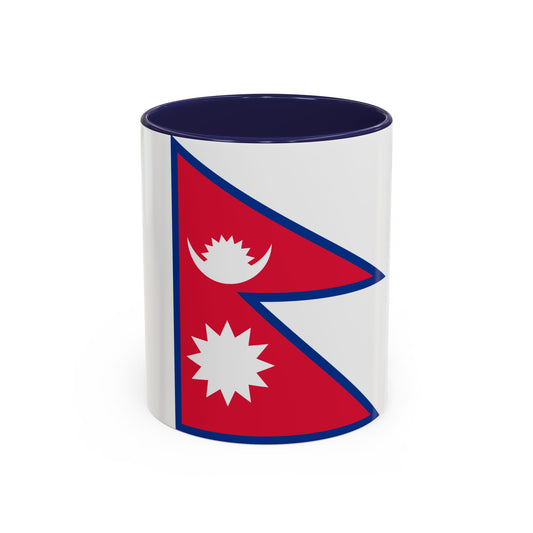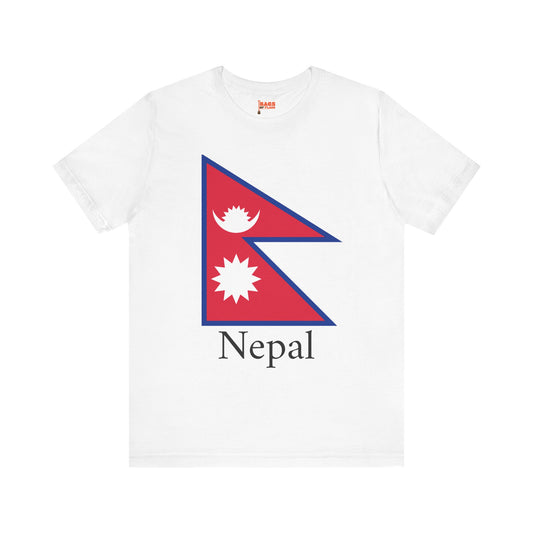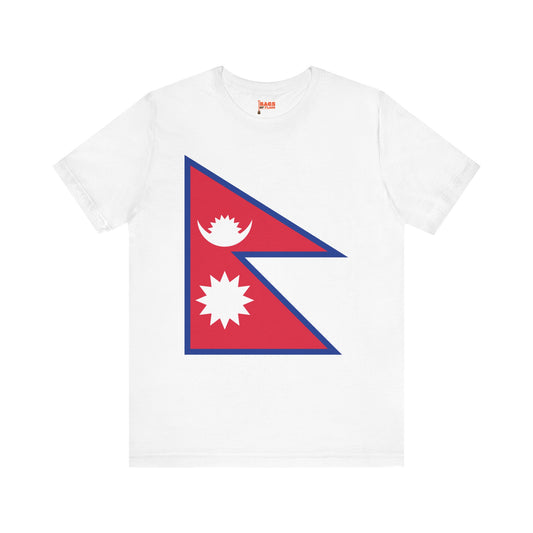-
Nepal Flag Sweatshirt
Regular price $34.15 USDRegular priceUnit price / per -
Nepal Backpack
Regular price $59.79 USDRegular priceUnit price / per -
Nepal Trucker Cap
Regular price $14.90 USDRegular priceUnit price / per -
Nepal Hoodies
Regular price $34.40 USDRegular priceUnit price / per -
Nepal T-shirts
Regular price $22.79 USDRegular priceUnit price / per -
Nepal Flag Hoodies
Regular price $34.40 USDRegular priceUnit price / per -
Nepal Flag on T-shirt
Regular price $22.79 USDRegular priceUnit price / per
Collection: Nepal
The Nepal flag symbolizes pride and identity for the people of Nepal. It is unique with its non-rectangular shape and combination of two triangles. We will delve into the history, symbolism, and controversies surrounding the Nepal flag.

Overview of the Nepal Flag
Unique in its form, the Nepal flag breaks away from the conventional rectangular shape, presenting a distinctive composition of two overlapping crimson triangles bordered by a deep blue. White emblems at the heart of the flag punctuate the vibrant red: the upper triangle houses a stylized moon, while the lower triangle features a radiant sun. This striking color scheme is visually compelling and rich in meaning. Crimson is a tribute to the courage of the Nepali warriors, whereas the blue perimeter encapsulates the nation's aspiration for peace and harmony. The celestial symbols embedded in white add layers of significance, embodying the enduring nature of the country and its aspirations toward progress and enlightenment. This juxtaposition of elements and colors weaves together a historical and aspirational narrative, reflecting the soul of Nepal and its people.
Historical Context of the Nepal Flag
The design of the Nepal flag, with its distinctive non-rectangular shape, was officially adopted on December 16, 1962, marking a significant moment in the nation's history. This flag's origins can be traced back to much earlier times, evolving through various iterations before reaching its current form. The flag's evolution reflects Nepal's rich tapestry of history, from the era of monarchies to its journey towards a democratic governance structure.
Nepal's flag underwent significant transformations, especially during the 19th century under the Rana dynasty's rule. Initially, the flag featured simpler designs that included moon and sun elements, indicative of the country's long-standing symbols. The move from these earlier versions to the current design was not merely aesthetic but symbolic, representing shifts in political power and social values within the country.
This transition was closely tied to pivotal historical events, including the struggle for democracy and the overthrowing of the Rana regime. Adopting the current flag design in 1962 was a declarative act of the country's new democratic identity and aspirations, signaling a break from past regimes and a step towards establishing a more inclusive national identity. This flag has since stood as a testament to Nepal's enduring spirit and people's peace, unity, and progress aspirations.
Symbolism Behind the Design and Colors

The symbolism woven into the Nepal flag's design and palette is rich with national and cultural significance. The dual triangles symbolize the towering Himalayas and echo the ancient Hindu symbols of water and fire, reflecting harmony between the natural elements. Crimson, the primary color of the flag, is a nod to the bravery and courage of the Nepali people, a legacy of the fierce Gurkha warriors. It also represents the rhododendron, Nepal’s national flower, adding a layer of natural beauty to the flag’s significance.
The deep blue border encapsulates a desire for peace and harmony with its neighbors and the nation. Meanwhile, the celestial symbols—the moon and the sun—highlight the country's hope for longevity and constancy; the moon suggests the cool weather of the Himalayas and the calming serenity of the night, while the sun conveys warmth and vitality, and the perpetual nature of life. These elements represent a narrative of resilience, hope, and unity, underscoring the profound connection between the Nepali people, their land, and their aspirations for the future.
Current Relevance of the Nepal Flag
Today, the Nepal flag maintains its significance as an emblem of national sovereignty, used prominently at state functions, military ceremonies, and public holidays. It fluttered atop government buildings, schools, and public squares, symbolizing the country's unity and independence. Its presence during international diplomatic affairs, sports events, and Nepali diaspora gatherings abroad reinforces the connection and pride among Nepalis worldwide.
Despite its revered status, the Nepal flag has stirred debates, particularly over its unique shape, which presents practical challenges in a world accustomed to rectangular standards. Critics argue that this distinctive design complicates its placement among the flags of other nations, leading to discussions about the balance between tradition and global uniformity.
Moreover, the flag's distinctive characteristics have sparked interest in its meaning and protocol, drawing attention to preserving national heritage while engaging with the international community. As such, the Nepal flag symbolizes the nation's past and aspirations and invites ongoing conversations about its role in a rapidly changing world, reflecting the dynamic nature of national identity and pride.
Additional Facts and Protocols
The handling and display of the Nepal flag are governed by a set of prescribed protocols emphasizing its significance and the reverence it commands. Among these, the flag must be displayed in a manner that ensures its dignified representation at all times. Significantly, when the flag is raised or lowered, it is a tradition to honor it with a salute, acknowledging its symbolic importance to the nation.
An intriguing aspect of the Nepal flag is its unparalleled design, which deviates from the traditional rectangular format seen with other national flags. This unique feature has implications for its display, particularly in international settings where uniformity is standard. The protocols extend to its fabrication, ensuring that the dimensions and elements of the flag maintain precise proportions to preserve its historical and cultural authenticity.
The Nepal flag's distinctiveness also includes specific instructions on how it should not be used. For instance, it must never touch the ground or be used in a manner that could be construed as disrespectful. Moreover, there are guidelines for its use alongside other flags, ensuring it is positioned with honor and respect.
This respect for the flag is further demonstrated in how it is integrated into national life. The flag is flown at half-mast during national mourning, a symbol of the nation's collective sorrow. Such protocols highlight the deep connection between the flag and the Nepali people, constantly reminding them of their shared values, history, and aspirations.
















